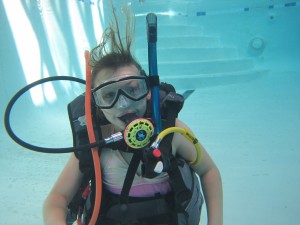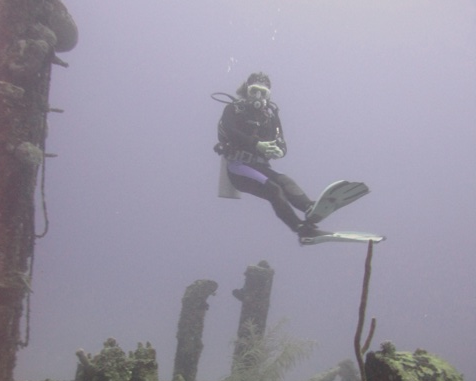PADI has had the most popular entry-level scuba course in the world market for years, the PADI Open Water Diver Course. In 2013, they released a revision of this popular program with some great enhancements. Suggestions from divers over the past several decades and input from PADI Instructors around the globe went into this revision. Why change a program that has worked amazingly well? [PADI certifies the majority of Open Water Divers around the world, often 75-85% each year.] Input from what divers want and what they found out when they left the course as well as ways to make divers safer.
Enough about how great the PADI Open Water Diver Course is, let’s look at what goes on in the course. The course is broken up into three segments: knowledge development, confined water and open water. What does that mean?
Knowledge Development: when I learned to dive, this meant reading a chapter in the student manual, then going to a two-hour lecture where they showed a video, actually lectured from slides and then had us take a quiz. Who has time for that these days? [We can still do it, if you want, but…] We’ve options for this now. There are five sections in knowledge development. You can do independent study with the course manual and DVD, then we just meet and do a quick review and take a quiz for each of the first four sections and a final exam for the fifth section. Or, you can complete eLearning, an online version of the manual and video. Then we don’t even meet for quizzes. You only take a quick review quiz when you’re completely done with knowledge development. Coming later in January 2013, Open Water Touch will be released for Apple iOS products like the iPad (Android version following later in first quarter 2013). This is an app for your tablet. Once it’s installed, you don’t need an internet connection—great if your connectivity is iffy or if you’ll be traveling. For this version, we’ll still meet for quizzes and a final. Open Water Touch brings the best of all worlds in an interactive learning environment you can take with you. That’s the way to go.
Confined water: Pool training if there’s a pool, or open water that has pool-like conditions if there isn’t a pool. Let’s face it, you don’t learn to dive from reading a book or watching a video. The Knowledge Development section supports you learning the motor skills of diving. This is one of the places the revised PADI Open Water Diver course shines. We used to teach and evaluate most skills with you kneeling on the bottom. Divers don’t dive kneeling on the bottom. In fact we heavily encourage you don’t even touch the bottom in an open water environment, but we’ve been training that way for years. Now, we try to get you, the new diver, into a trim and neutrally buoyant position early in the program. While we used to make sure you were competent with the skills, as Instructors we didn’t always know if you felt confident about them or if you could apply them in a situation where you weren’t kneeling on the bottom. The revised course fixes that. We also spend more time on planning your dives, so you’re not relying on an instructor to plan every dive you ever go on.
Open Water: Confined water was a good place to teach, but it was a pool or pool-like. The ocean is big. I mean really big. No four walls like on your pool. Pools typically don’t have waves and they’re typically no deeper than 12ft/4m. You need to practice what you learned in confined water in a much bigger environment. Some sites require you to use a boat to get there, others require a bit of a walk over rocks or with mud—things we can’t really simulate in a pool. You’ll practice skills on three dives and your fourth dive will be one you plan with your buddy under the Instructor’s supervision. Your instructor will closely supervise the dive. If you had some issues on the third dive, your instructor might also do some additional training with you before letting you conduct the portion you and your buddy planned. These four dives will be conducted over at least two days. Depending on your dive environment and logistics, your instructor might also integrate skills and specialty techniques for the environment and you might be able to earn an additional specialty certification at the same time as your PADI Open Water Diver Certification, for example the Altitude Diver Specialty if you’re diving at Altitude or Boat Diver if you’re doing all the dives from a Boat.
After successfully completing all three sections, you will earn the PADI Open Water Diver Certification. This is probably the best recognized diver certification in the world. While you only have to earn this certification once in your life, if you’re not diving often, your knowledge and skills deteriorate. You should plan on diving frequently or completing additional training or, at a minimum, refresher training before you make dives after a period of inactivity.

